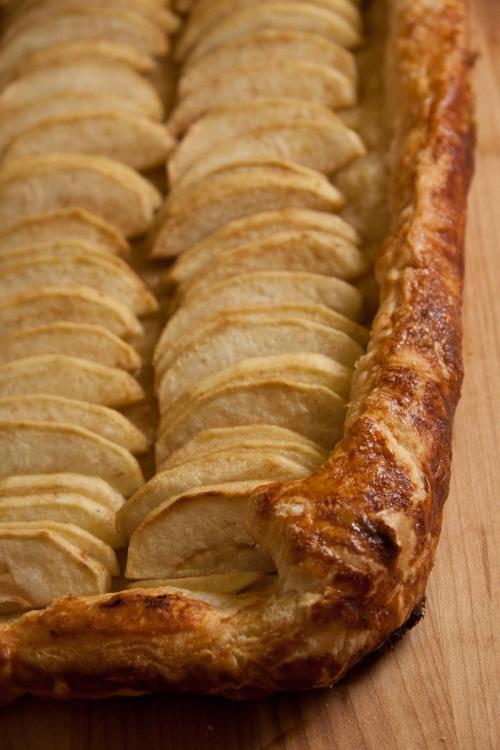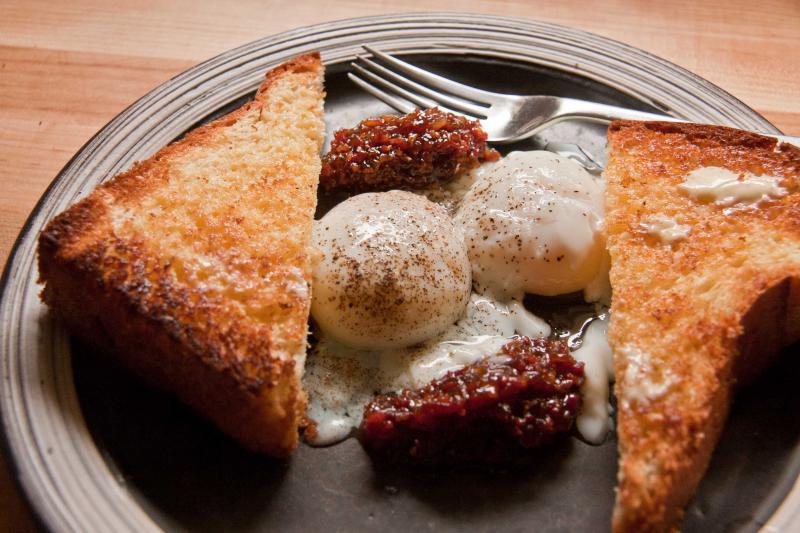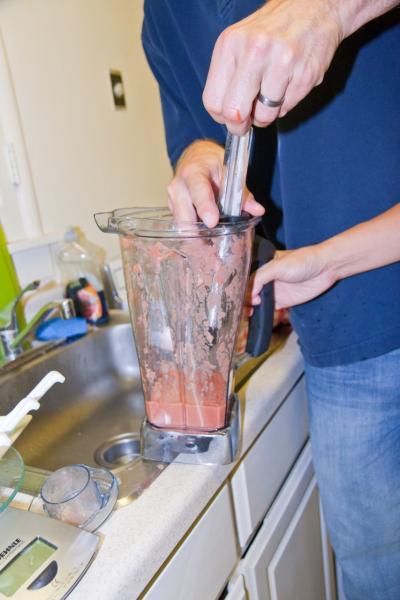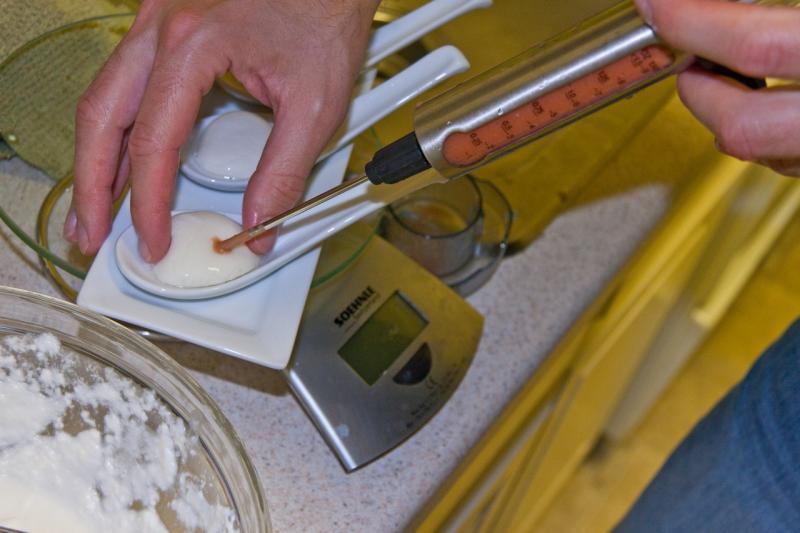
Borgstrom
-
Posts
130 -
Joined
Content Type
Profiles
Forums
Store
Help Articles
Posts posted by Borgstrom
-
-
-
The ovens are 44" wide, 29" high, and -- eek -- 20" deep.
Nice kitchen!
Depending on your budget, a Rational Combi might be an option, although you'd have to blow out the back wall to accommodate the depth - the CombiMaster 62 is about 42w x 29h x 38d.
-
-
i am really enjoying this:
no slots, so any knife can go anywhere you like it. it is oddly satisfying to stick the knives into. i need another one.
I used the Kapoosh for a while, but have abandoned it. I just could't fit some of my larger knives in it.
I've now moved to a Mag Blok and couldn't be happier. The knives touch nothing but wood and I have more countertop space. Besides, I can more easily admire my new DT blades!

-
-
Soft-boiled Egg with Toasted Brioche and Bacon Marmalade
From Thomas Keller's "Sous Vide: A guide to low-temperature cooking".
Eggs cooked at 64C for 1 hour. I will make the eggs again, but the bacon marmalade (made with ground bacon, minced onion, red wine vinegar, honey) wasn't worth the effort -- just too sweet and sticky for my taste.
I also think I need to work on my SV egg plating skills -- all the runny whites tasted fine, but certainly aren't photogenic...
-
IAfter reading through those comments I thought that I would get the Devin Thomas knife: http://www.chefknivestogo.com/dethfo270abg.html, A 270 mm Gyuto, but it is now unfortunately out of stock. I am shopping for my birthday (or Christmas if the search takes too long).
It does take a bit of luck+timing to score one of these. I got very lucky & Santa came early this month with two new Devin Thomas knives -- a 240mm Gyuto and a 150mm Petty. I've just had them a few days & haven't really put them through their paces yet, but so far I'm very impressed. Fit & finish are excellent, and their balance/feel are very good to my hand. I can already tell that these will quickly become my go-to knives after 20 years with my Henckels 4-Star set.
-
I'm an engineer by training and get spammed by lots of technical publishers. Normally I ignore this kind of junk email, but the one below from Food Engineering Reviews caught my eye. I imagine this journal is obscenely expensive (as most technical pubs are), but the publisher is providing free article downloads through December 31, 2010. These articles may be interesting reading for curious foodies and budding food engineers, and may provide some insight into the next advances in modernist cuisine. For example, their December 2010 issue has the following articles:
The Use of Electric Fields for Edible Coatings and Films Development and Production: A Review
High Pressure Processing of Meat, Meat Products and Seafood
Polymeric-Based Food Packaging for High-Pressure Processing
Some interesting articles from earlier issues:
Nanoencapsulation: A New Trend in Food Engineering Processing
Enhanced Extraction from Solid Foods and Biosuspensions by Pulsed Electrical Energy
Shelf-Life Testing of Coffee and Related Products: Uncertainties, Pitfalls, and Perspectives
Selected Applications of Ultrasonics in Food Processing
You can find all of the issues/articles at this link:
http://www.springerlink.com/content/1866-7910/2/4/
Enjoy!
A Message from the Editor-in-Chief:
Welcome to Food Engineering Reviews. To briefly summarize the goal of this journal, Food Engineering Reviews endeavors to present high quality reviews of state-of-the-art identified topics that range from the classical to modern engineering aspects of food processing, in which authors are encouraged to include their own work.
In addition to unsolicited reviews, the journal also publishes Special Issues including 6 to 8 peer-reviewed articles and focused in a given topic proposed by a Guest Editor and approved by the journal editors. To suggest and lead the publication of a Special Issue is open to the readership, and we encourage submitting proposals to any of the members of the Editorial Board.
We want to make this journal one of the main sources to find the leading edge information on food engineering. This is the commitment of the editors, the editorial board and Springer.
Gustavo V. Barbosa-Canovas
Submit Online
Food Engineering Reviews publishes reviews covering all engineering aspects of today's food industry. Coverage concentrates on classic as well as modern novel food engineering topics, exploring such essential factors as the health, nutritional, and environmental aspects of food processing. The journal identifies and discusses trends that will drive the discipline over time.
The scope of topics addressed is broad, encompassing:
Transport phenomena in food processing
Food Process Engineering
Physical Properties of foods
Food nano-science and nano-engineering
Food equipment design / Food plant design
Modeling food processes
Microbial inactivation kinetics
Preservation technologies
Engineering aspects of food packaging
Shelf life, storage and distribution of foods
Instrumentation, control and automation in food processing
Food engineering, health and nutrition
Energy and economical considerations in food engineering
Food engineering education
Fast and easy submission via:
www.editorialmanager.com/fere
Free Access to Selected Articles
I would like to invite you to read the following articles published in Food Engineering Reviews for free and find out if your next article fits the scope of this journal.
The free trial access is valid until December 31st, 2010.
-
?You left them in the rice cooker for 20 hours?
I assume I misunderstand?
I've actually kept them warm as long as 72 hours. It stays above 140F in Keep Warm mode, so there is no risk of bacterial growth. The oatmeal tends to dry out after that long even with the lid closed, so I increase the water ratio a bit. I suppose I could (should?) just refrigerate and re-heat, but I got lazy once and left them in and found it didn't taste too bad.
-
Michael Voltaggio in his sous video for Williams Sonoma sv's turkey thighs in duck fat. No clue where to purchase in St. Louis, but chicken fat is readily available. In his video he recommends using the fat nearest the product he is cooking. I would think chicken fat would be similar to duck fat. Any thoughts???
In a trial run for Thanksgiving, I made some turkey confit tonight based on Keller's approach for duck confit. They turned out awesome - definitely a keeper in my growing sous vide repertoire!
The night before, I processed some kosher salt and fresh thyme together and packed around two whole turkey leg/thighs. I bagged these, vacuum sealed and kept in fridge overnight.
In the morning I rinsed the turkey off well with cold water, patted dry and bagged again with three tablespoons of duck fat. After vacuum sealing, I put in the water bath at 82C for 10 hours.
Just before dinner, I took them out of the water bath & de-bagged. The meat was falling-off-the-bone tender and very juicy. I tried doing a quick fry to crisp up the skin and add some crunchy bits, but the meat just fell apart in the hot oil. I ended up just lifting the limp skin off the meat and frying it separately into a nice crispy sheet to serve with the meat. Yum!
Edit: I actually got the duck fat from Amazon.com! It's really amazing what you can get there...
-
Much joy this morning. I used Borgstrom's approach more or less:
I add 1 cup of oats and 3 to 4 cups water, select the porridge setting (the first time I tried one of the rice settings and it boiled over, making a sticky mess), and set the timer to have everything ready at 7am.
I haven't figured out the timer part yet, so I just turned it on at 11p and they were holding steady at 7a. Excellent, though a bit less toothy than I'd like; I'll cut back on the water a bit.
So do you set the timer to start at 6a? Or what? I haven't used the timer before.....
You set the timer for when you want it finished; the cooker figures everything else out. It's nice to be awakened by the smell of cooking oatmeal at 6:30am, and then to hear the cooker's timer tune go off at 7:00am.
-
I adore steel-cut Irish oats like McCann's, and in a perfect world I'd have 'em ready to go every morning when I stumbled down the stairs. However, I don't really know how to do the overnight thing well.
Does anyone have a good method? I have a Zojirushi fuzzy logic rice cooker; would the congee setting work overnight? Ratios? Help?!?
Zojirushi actually has a recipe that shows how to prepare steel cut oatmeal.
-
I adore steel-cut Irish oats like McCann's, and in a perfect world I'd have 'em ready to go every morning when I stumbled down the stairs. However, I don't really know how to do the overnight thing well.
Does anyone have a good method? I have a Zojirushi fuzzy logic rice cooker; would the congee setting work overnight? Ratios? Help?!?
I use my Zojirushi fuzzy logic rice cooker to make Bob's Red Mill steel cut oatmeal a couple of times per month and am very happy with the results.
I add 1 cup of oats and 3 to 4 cups water, select the porridge setting (the first time I tried one of the rice settings and it boiled over, making a sticky mess), and set the timer to have everything ready at 7am. This usually makes enough oatmeal for 3-4 days, and the keep-warm feature lets me just keep the oatmeal in the cooker the entire time. It does get a bit thicker on day 3 or 4, so I eventually increased the water:oat ratio to 4:1.
In the morning, all I have to do is take out some hot oatmeal from the cooker, add brown sugar, walnuts, raisins and milk -- easy!
-
My wife likes half and half in hers and the only thing about it that I think unique is she puts the half and half in the mug than pours the coffee on top. No stirring necessary that way.
I do the same thing. I think it keeps the coffee warmer than that stirring business, and I swear I can taste the wood of wooden stirrers.
+1
Save the planet. Cream in cup first, then coffee.
-
Harvard has now posted videos of the first two public lectures on YouTube:
Harold McGee, Ferran Adria, José Andrés:
Sadly, it's now marked private.
You can also find them in iTunes:
http://itunes.apple.com/WebObjects/MZStore.woa/wa/viewPodcast?id=399227991
-
I get my Vita-Mix TOMORROW! I'm really excited. I'm expecting a couple weeks on a liquid diet.
In reading this thread I was disappointed that there weren't more recipes or fun experiments yielding new and interesting foods. It's first job is going to be purring a couple of kilos of spinach stems into juice, I think. I want to start playing with sauces after that. And ice cream, I've got to try the whole add a head of cauliflower and the kids'll never know thing.
Any fun stuff out there to try?
My VitaMix came in handy a couple of weeks ago when I made some mozzarella spheres from the Khymos recipe collection. The spheres were made with a mozzarella/cream mixture and an alginate bath. I used the VitaMix to liquify a really fresh tomato together with some salt and olive oil. I let it run for a while to warm the tomato juice, and then injected the result into the mozzarella spheres. It was a classic flavor combination, with a very interesting hot/cold twist.
-
Harvard has now posted videos of the first two public lectures on YouTube:
Harold McGee, Ferran Adria, José Andrés:
http://www.youtube.com/user/Harvard#p/c/546CD09EA2399DAB/0/odIegtceB4M
Joan Roca
http://www.youtube.com/user/Harvard#p/c/546CD09EA2399DAB/1/ulO-gGfqL6U
The public lectures are great, but wouldn't it be great to actually be able to take the class?
If Food Network would produce stuff like this, I might start watching it again...
-
Food stains come off easily with BKF and minimal elbow grease. Make sure you get the powder version of BKF (liquid version doesn't work as well), and use minimal water. I usually just rinse the pan out quickly and use the residual water with BKF. Fantastic stuff.
All of the All Clad I have is Stainless; I don't have any experience with MC2 or their other lines.
-
I've got a bunch of All Clad Stainless pieces and couldn't be happier. I've had them 10+ years now and have no complaints. My next stove will be induction, so I'm happy that I won't need to update my cookware! All Clad Stainless were designed from the beginning to be induction-ready.
Regarding the finish -- they have held up very well. I really use mine, so they have the usual assortment of light scratches, etc. But they still look great and when friends come over to cook they often comment on how nice it is to use high-quality cookware. One essential item: Bar Keepers Friend. This is the absolutely best cleaning powder in the world for removing residue from high-heat cooking on the 12" saute pan. What would take a good 20 minutes with normal soap and a scour pad will come off in 1-2 minutes with BKF, a few drops of water and a light scrub. Magical stuff!
One observation is with nonstick fry pans: they wear out eventually--even All Clad. After my All Clad nonstick pan wore out I just started getting cheaper pans from a restaurant supply store. A good quality 8" or 10" pan costs in the $20-$30 range, so it's not so bad replacing them every few years.
-
What type of proteins are you cooking? In my opinion, torches are mostly useful for beef. They aren't so useful on poultry or pork (except perhaps very fatty cuts like ribs).
So far I've used the MAPP torch on SV chicken (skinless breast, thigh) and seafood (shrimp chorizo); haven't tried it on beef yet. Maybe the lean protein is the issue -- perhaps a light coating of oil before torching would help even things out. If not then I'll just have to break down and sear on a hot skillet. One more thing to wash ...
I bought a bernzomatic (sp?) MAPP self lighting torch from Home Depot as I needed for beef and couldn't wait to order the iwatani. I have been pretty happy, it works quickly, I can't imagine going much hotter. The flame has sort of two cones an inner bright whitish-blue and a more faint outer blue. The whiter flame is hotter, so my goal has been to keep the meat just out of range of the whiter flame and to keep it moving (sort of like spray painting). I can get a reasonable crust on one side of a filet mignon in roughly 45 seconds (I have not dried it first - which may speed up the process, but hard to imagine it going much quicker.) This might help you calibrate times.
Thanks for the advice; I'll try your technique on my next filet!
-
Buy a propane torch, but use MAPP gas.
MAPP is similar to propane but it burns hotter, and has less of an issue with flavor transfer.
I prefer "self-lighting" or "trigger start" propane torches. They are about $50 - available at Amazon, or Home Depot.
Even better, in my view, are torches that give you a hose between the tank and the torch - they are much less tiring to hold. here is an example.
The non-self lighting torches are cheaper - less than $20.
I picked up a MAPP torch from Home Depot but haven't figured out how to achieve appealing browning on my SV proteins with it. The flame is so hot it burns surface irregularities before browning the overall surface. I've only used it 2-3 times so far, so I need to experiment a bit more with how far to hold it away from the food, how quickly to move it, etc. Perhaps drying the protein surface and/or coating with a light glucose solution would help. I'm also thinking about getting a flame spreader attachment. Does anyone have advice on technique using MAPP torches?
I'm also now wondering if the extra heat of the MAPP gas vs. propane is useful in culinary applications. If you have to hold the flame farther away or move it faster across the protein then it seems the extra heat is not really being taken advantage of. nathanm said something similar ("A propane torch is already hot enough that there is no increased utility in MAPP.") a few years back, but seems to prefer MAPP now. Perhaps there are some other advantages to MAPP?
-
As far as 3 minutes deep fry vs. torch: I've got a blazing hot MAPP torch, but haven't been too happy with the results so far. It seems to burn the surface irregularities before really browning anything. Perhaps I need to refine my technique.
MAPP burns extremely hot, and might not be the best choice. Also, it often has odorants added to it so that you can smell it, which can damage the taste of food. Propane might be the better choice for the kitchen.
I haven't noted any off odors, but it sure does burn hot. I was browning off some SV chicken breasts last week in an aluminum-foil lined baking pan using the torch. The torch burned right through the foil, even though the flame was only hitting the chicken. Next time I'll just put them in a cast iron pan for torching...
BTW, on the massive Sous Vide thread, Nathan M. recommends MAPP gas (post 3539). I've found his guidance to be pretty good so far.
-
-
I was surprised by how brown they were as well. I checked the internal temp with a thermapen just after taking them out of the circulator -- they were at 59.5C, so I don't think it is a circulator temp issue.
I did not shock them after pulling out the bags -- they went from circulator to 185C oil in the span of about 10 minutes. Could shocking them in an icewater bath make that big of a difference? I would be surprised, but who knows...I'm new at this.
As far as 3 minutes deep fry vs. torch: I've got a blazing hot MAPP torch, but haven't been too happy with the results so far. It seems to burn the surface irregularities before really browning anything. Perhaps I need to refine my technique. In any event, for the short ribs I was following the Momofuku instructions which called for oil. Looking at the result, I don't think the heat from the oil penetrated deeply at all; the ribs had a very thin crust followed by perfectly consistent color all the way through -- no banding at all.










Help! I need suggesions for striped bass.
in Cooking
Posted
I made Striped Bass with Roasted Poblano Vinaigrette and Yellow Pepper Grits from Bobby Flay's Mesa Grill Cookbook a few weeks ago and was very happy with the results, especially the roasted poblano vinaigrette. Next time I'd probably cut back on the cream in the grits to make it a bit less rich, and increase the skillet temperature to get crispier skin.